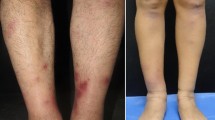Summary
Electronmicroscopical examination on skin lesions of epidermolysis bullosa dystrophica recessiva (E.b.d.r.) and epidermolysis bullosa acquisita (E.b.a.) associated with Crohn's disease have demonstrated that blistering occurs between epidermis and dermis beneath the basal lamina. The structural defect concerns the anchoring fibrils only which are missing in the junctional zone of the involved skin. All other junctional structures are intact.
Beneath the basal lamina a band-like zone of a moderate electrondense, amorphous material is seen in the skin-lesions of epidermolysis bullosa acquisita, less marked in epidermolysis bullosa dystrophica.
Direct immunofluorescent investigation of involved skin of E.b.a. shows a pemphigoidlike fluorescent pattern at the basal lamina with antihuman IgG-, -IgM-, -β 1c/β 1a and antihuman C1q-component. In epidermolysis bullosa dystrophica, however, a fluorescent pattern at the basal lamina was found only with anti-human IgG and Anti-C3.
The pathogenetic importance of the immunoglobuline-deposits at the basal lamina is discussed in regard of the loss of anchoring fibrils and the subsequent vesication in these types of epidermolytic diseases.
Zusammenfassung
Elektronenmikroskopische Untersuchungen an Hautläsionen je eines Falles von Epidermolysis bullosa dystrophica recessiva (E.b.d.r.) und Epidermolysis bullosa acquisita (E.b.a.) bei Morbus Crohn ergaben, daß die Blasenbildung bei beiden Erkrankungen zwischen Epidermis und Dermis unterhalb der Basallamina erfolgt. Der strukturelle Defekt betrifft nur die “anchoring fibrils”, welche an der Junktionszone der klinisch befallenen Haut fehlen. Die übrigen für die Verknüpfung von Epidermis und Dermis notwendigen Haftstrukturen sind dagegen intakt.
Unterhalb der Basalmembran findet sich bei der E.b.a. eine bandförmige Zone eines mäßig elektronendichten amorphen Materials, welches bei der E.b.d. weniger ausgeprägt ist.
Direkte Immunfluorescenzuntersuchungen an befallener Haut bei E.b.a. ergaben ein Pemphigoid-ähnliches Fluorescenzmuster an der Basallamina nach Beschichtung mit Anti-IgG-,-IgM-, -β 1c/β 1a- und der C1q-Komponente. Bei der E.b.d. fand sich nur ein Fluorescenzstreifen mit Anti-IgG- und Anti-β 1c/β 1a.
Die pathogenetische Bedeutung der Immunglobulinablagerungen an der Basallamina wird unter Berücksichtigung des Fehlens von “anchoring fibrils” und der daraus folgenden Blasenbildung bei diesen epidermolytischen Erkrankungen diskutiert.
Similar content being viewed by others
Literatur
Anton-Lamprecht, I., Schnyder, U. W.: Epidermolysis bullosa dystrophica dominans — ein Defekt der anchoring fibrils? Dermatologica (Basel)147, 289–298 (1973)
Bazex, A., Dupré, A., Balas, D., Broussy, R., Bonafe, J. L., Cantala, P., Bazex, J.: Epidermolyse bulleuse dystrophique. Bull, Dermat.81, 193–198 (1974)
Briggaman, R. A., Dalldorf, F. G., Wheeler, C. E.: Formation and origin of basal lamina and anchoring fibrils in adult human skin. J. Cell. Biol.51, 384–395 (1971)
Briggaman, R. A., Wheeler, C. E.: Studies on the pathogenesis of recessive epidermolysis bullosa dystrophica. J. invest. Derm.60, 109 (1973)
Daróczy, J.: Elektronmikroszkopos megfigye lések Epidermolysis bullosa recessiv dystrophias formájánek egy estében. Bórgyög, vener. Sz.48, 10–16 (1972)
Doe, F. W., Booth, C. C., Brown, D. L.: Evidence for complement-binding immune complexes in adult coeliac disease, Crohn's disease and ulcerative colitis. Lancet1973, 402–40
Frank, H.: Persönliche Mitteilung
Frank, H., Metz, J.: Immunfluorescenzmikroskopische Untersuchungen bei Erythema nodosum und Vasculitis allergica. Z. Haut u. Geschl.-Kr.48, 419–423 (1973)
Gibbs, R. B., Minus, H. R.: Epidermolysis bullosa acquisita with electron microscopical studies. Arch. Derm.111, 215 (1975)
Hashimoto, J., Anton-Lamprecht, I., Gedde-Dahl, T., Schnyder, U. W.: Ultrastructural studies in epidermolysis bullosa hereditaria. I. Dominant dystrophic type of Pasini. Arch. Derm. Forsch., im Druck
Kiistala, U., Mustakallio, K. K.: Dermo-epidermal separation with suction. J. invest. Derm.48, 466–477 (1967)
Kushniruk, W., Sask, S.: The immunpathology of epidermolysis bullosa acquisita. C.M.A. J.108, 1143–1146 (1973)
Metz., G., Metz, J., Frank, H.: Epidermolysis bullosa acquisita bei Morbus Crohn. Hautarzt26, 321–326 (1975)
Metz, J.: Elektronenmikroskopische Untersuchungen an allergischen und toxischen Epicutanreaktionen des Menschen. Arch. Derm. Forsch.245, 125–146 (1972)
Misgeld, V., Schmidt, H., Wogenstein, M.: Hepatische Porphyrien. Z. Haut- u. Geschl.-Kr.48, 585–591 (1973)
Neering, H., Wesseldijk, W.: Recessive epidermolysis bullosa et albopapuloidea without nail dystrophy and scarring. Dermatologica (Basel)149, 176–192 (1974)
Orfanos, C. E.: Feinstrukturelle Morphologie und Histopathologie der verhornenden Epidermis. Stuttgart: Thieme 1972
Palade, G. E., Farquhar, M. G.: A special fibril of the dermis. J. Cell. Biol.27, 215–275 (1962)
Pearson, R. W.: Studies on the pathogenesis of epidermolysis bullosa. I. invest. Derm.39, 551–575 (1962)
Pearson, R. W.: Some observations on epidermolysis bullosa and experimental blisters. In: The epidermis, pp. 613–626, Hrg.: Montagna, W., Lobitz, W. New York: Academic Press, Inc., 1964
Pearson, R. W.: Epidermolysis bullosa, Porphyria cutanea tarda, Erythema multiforme. In: Zelickson. Ultrastructure of normal and abnormal skin. Philadelphia: Lea and Febiger 1967
Pearson, R. W., Potter, B., Strauss, F.: Epidermolysis bullosa hereditaria letalis. Arch. Derm.109, 349–355 (1974)
Roenigk, H. H., Ryan, J. G., Bergfeld, W. F.: Epidermolysis bullosa acquisita. Arch. Derm.103, 1–10 (1971)
Seah, P. P., Fry, L., Rossiter, M. A., Hoffbrand, A. V., Holborow, E. J.: Anti-reticulin antibodies in childhood coealiac disease. Lancet1971, 681–682
Seah, P. P., Fry, L., Hoffbrand, A. V., Holborow, E. J.: Tissue antibodies in dermatitis herpetiformis and adult coeliac disease. Lancet1971, 834–836
Vogel, A., Schnyder, U. W.: Feinstrukturelle Untersuchungen an rezessiv-dystrophischer Epidermolysis bullosa hereditaria. Dermatologica (Basel)135, 149–172 (1967)
Vogel, A., Schnyder, U. W.: Zur Struktur und Funktion der Basalmembran und ihrer Anhangsgebilde. Befunde an Normalhaut und bei der Epidermolyse. 4. Symp. Dermat. cum Particip. Int. Brno 1970
Weidner, F.: Persönliche Mitteilung
Wellek, B., Opferkuch, W.: Die klinische Bedeutung des Komplements. Dtsch. med. Wschr.98, 2356–2361 (1973)
Woerdemann, M. J.: Epidermolysis bullosa dystrophica acquisita. Dermatologica (Basel)149, 184–186 (1974)
Author information
Authors and Affiliations
Additional information
Auszugsweise vorgetragen auf dem 2. Oberkochener Gespräch am 3. u. 4. April 1975.
Rights and permissions
About this article
Cite this article
Metz, J., Frank, H. & Metz, G. Zur pathomorphogenese der blasenbildung bei epidermolysis bullosa acquisita und epidermolysis bullosa dystrophica. Arch. Derm. Res. 254, 103–112 (1975). https://doi.org/10.1007/BF00561541
Received:
Issue Date:
DOI: https://doi.org/10.1007/BF00561541




